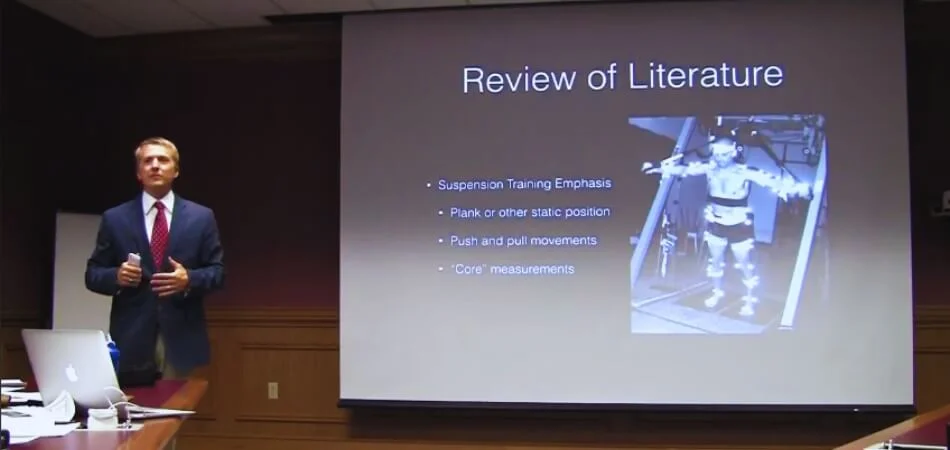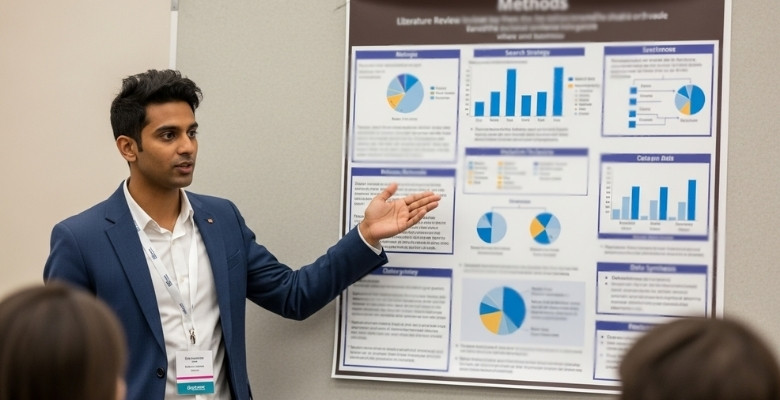Conferences bring people together to share ideas, research, and insights in many fields. In such settings, you might often think about how do you present a literature review in a conference? This question becomes important because it determines how your work is received.
Present a literature review at a conference by clearly stating the research gap, organizing key studies around a central theme, and highlighting what is missing. Use simple visuals, avoid dense text, and adjust your explanation to the audience’s level. End with one memorable takeaway that reinforces your review’s value.
Do you want to know the best ways to plan, design, and deliver a literature review talk that keeps your audience engaged from start to finish? If so, this article will give you every detail you need in one place.
How Do You Present a Literature Review in a Conference?
Speaking at a conference is a chance to share your work. A literature review can be a strong part of your talk. It helps show what is already known and what is missing. Let’s explore how you can present it in the best way.

Core Aim
When presenting, the goal is to show what others have discovered, where gaps remain, and why they matter. Highlighting these points helps the audience see the value in your work. It is not about repeating studies but about connecting the bigger picture.
Clear Focus
A focused review always begins with a simple guiding question. This helps you shape your methods, findings, and overall takeaway. The audience can follow along without confusion when your content is built around one main idea instead of scattered thoughts.
Audience Fit
Think carefully about who will hear your presentation. Experts might understand complex terms, but others may not. Choosing the right level of detail makes a big difference. If you’re planning for upcoming conferences, keep words simple and explanations clear.
Story Flow
Every good review works like a story that people can follow. You start broad, move into specific details, and then highlight the action. This order makes it easy for listeners to connect the dots and remember the most important points.
Visual Support
Adding charts, slides, or diagrams helps make your points stronger. Too much text on slides will lose attention quickly. Use visuals that are simple, clean, and clear. They should support your words, not replace them, and they must highlight key ideas only.
Time Balance
Every conference talk is limited by strict time rules. Practicing your review in advance makes sure you cover everything at the right pace. Spending too long on one part may cause you to rush through the end. Balance keeps your talk clear.
Key Gaps
Pointing out gaps is what makes your review valuable. Instead of repeating what others have said, show what is missing. This makes your audience see the importance of your work. A clear gap means there is room for new ideas.
Finish Line
A final line should leave the audience with one strong thought. Make it short, memorable, and easy to recall. People often remember the last words most clearly. Ending with a single, powerful message makes your talk stick long after it ends.
Presenting a literature review takes planning and clear delivery. Each part should connect smoothly to the next idea. Practicing helps you share your thoughts with confidence and timing. A strong finish makes your presentation easier to remember afterward.
How Do You Structure a Literature Review Conference Abstract?
This review looks at how climate change research has grown worldwide. Many new studies have come in from science, health, and policy. The work has shown both strong results and weak research areas. This abstract presents the main findings, key gaps, and the next step.
Purpose Line
The goal here is to look at how climate change studies have developed. It focuses on showing what has been studied and what has been missed. The review helps explain where progress has been made and where gaps remain. It sets a clear ground for needed research work.
Scope Window
The review covers studies published between 2010 and 2024 in many fields. It looks at health, environment, agriculture, and energy research done worldwide. Studies include reports, surveys, reviews, and trials from different scientific and social sources. The focus remains on global patterns and cross-field connections.
Methods Note
Searches were completed in Web of Science, Scopus, and PubMed databases. The key terms included “climate change,” “impact,” “adaptation,” and “mitigation.” Only peer-reviewed journal articles and conference papers were included for this review. References were carefully checked to ensure strong sources and reliable evidence.
Key Findings
The review found that climate change studies grew fast in recent years. Many papers reported strong health risks linked with heatwaves and pollution. Other work showed clear progress in renewable energy and farming adaptation. Still, most studies reported uneven results depending on regions and available resources.
Gap Signal
Research is still lacking in showing climate effects on small rural areas. Many poor regions have very little coverage in existing research papers. Long-term health impact studies are also very rare and uneven. Data gaps remain wide for vulnerable groups and low-income countries.
Takeaway Line
Future work should give more attention to poor and rural communities. New studies should cover long-term health outcomes linked to climate change. Cross-field projects can help combine environment, energy, and health studies together. Practical steps should focus on inclusive action and fair global coverage.
Here’s a PDF sample you can check out.
How Should Methods for a Literature Review Be Shown in Conference?
Sharing methods for a literature review at a conference works best when you keep things short and clear. This gives your audience the full picture without too much detail. You just need to show where you searched, how you searched, what you picked, and how you checked the quality. Here’s how you can do that in a simple and clear way.
Let’s break it down into five small parts below so you can easily show everything step by step.
Sources Named
Mention where you got the studies from and include the years you looked at. For example, you can say something like: “We searched PubMed, Scopus, and Google Scholar for papers published between 2015 and 2024.” This one line tells people what databases you used and the time frame. Keep it short but complete so it’s easy to read quickly on a slide.
Search Terms
Show two or three main keyword phrases that you used to look for studies. You don’t need to write out every variation. For example, write: “(‘climate change’ AND ‘crop yield’), (‘global warming’ AND ‘agriculture’).” These search strings help people understand what topics you focused on. Use quotes and AND/OR to keep them sharp and clear.
Selection Steps
Tell how many studies you found first, how many you checked after, and how many you finally used. For example: “Found 500 studies, screened 200 by title and abstract, included 35 in final review.” This helps people understand how you filtered the data. Use round numbers or exact counts if you can.
Criteria Clear
List short points that explain what kind of studies you picked and what you left out. For example:
- Included: Peer-reviewed, English language, published 2015–2024
- Excluded: Duplicates, opinion articles, studies without full text
This makes it super easy for others to know your selection rules without needing a long explanation.
Quality Check
Let people know how you checked if the studies were good. You can say: “Used the CASP checklist to assess study quality.” Or if you used another tool, just name it. This shows that you didn’t just pick any study—you checked if the work was done properly.
These five parts help keep your review method clean and simple for any conference audience. You can follow this pattern to make your presentation slide clear and easy to follow.
Which Visuals Help a Literature Review in a Conference?
Presenting a literature review at a conference requires visuals that make an impact. Clear visuals save time and help the audience quickly see your main points. A good balance of text and graphics makes the talk easier to follow and more engaging. Let’s look at some simple options that can be very effective.
- PRISMA Mini: A small four-box diagram with counts for found, screened, excluded, and included studies gives a quick process view.
- Compare Table: A 4×3 table helps display key study details like author, year, method, and outcome in a compact and organized way.
- Concept Map: Three to five themed nodes with connecting lines show relationships clearly and make it easier to understand linked ideas at a glance.
- Simple Chart: A single bar or line chart works well to highlight one main result or trend without overwhelming the audience with too much data.
- Icon Cues: Small icons next to text, such as a book for method or a check mark for outcome, guide the audience’s eyes smoothly.
- Clean Layout: Simple spacing, readable fonts, and balanced colors make visuals stand out without creating clutter or distraction on your slides.
- Short Labels: Keep titles and captions very short so the focus stays on the graphic, allowing people to grasp your point immediately.
Clear visuals not only explain complex points but also make starting conference presentation slides more engaging for the audience right from the beginning. Keep them simple, neat, and well-linked to your points to help your audience stay engaged.
How Do You Script a Literature Review Conference Talk?
This talk explores how literature review talks can be planned carefully. Many presenters often struggle with timing, flow, and audience connection. The method here gives simple steps for making a clear script. Each section builds on the last, making the full talk easy.
Hook Lines
A good start highlights one problem that makes the audience listen closely. Add one strong reason why the problem matters in real practice. The opening example must connect with people’s everyday lives or work. Keeping it short and sharp helps you gain trust right away.
Pace Target
Clear speaking needs steady timing that does not overwhelm your audience. Experts suggest speaking between 120 and 140 words every minute. This pace lets listeners follow the content without feeling rushed or confused. Practicing your talk out loud helps you stay on target.
Cue Notes
Speaker notes are helpful tools that guide delivery during live talks. You can mark [pause] to create silence and stress important points. Writing [next slide] ensures your speech matches the movement of slides. These small notes help keep the rhythm steady and reduce nervous mistakes.
Transitions
Smooth links between slides keep ideas flowing and hold the audience’s attention strongly. Use one short bridge line that moves from one point to another. For example, “Now let’s turn to methods” works perfectly. These connecting lines prevent confusion and support the larger story clearly.
Close Sentence
Ending lines should give one a clear message that people remember after leaving. Keep the sentence simple enough that anyone can repeat it easily. For example, “Better studies need clear planning and shared data” works. That way, your talk ends with a strong direction and a simple meaning.
Q and A
Being well-prepared entails having responses ready for any queries the audience may pose. Consider three potential questions and prepare a brief response for each. Example: “What sources were used?” → “Only peer-reviewed journals included.” Example: “What gap matters most?” → “Long-term impact research remains scarce.”
Here’s sample PDF you can check out
How Do You Handle Citations in a Conference Literature Review?
During a conference presentation, a literature review should include citations managed with care. This keeps your work credible and shows respect for the original authors. A neat system also makes it easier for your audience to follow. If you keep it clear and simple, people can understand your points better and trust your findings. Let’s look at a few easy ways to handle citations.
Short Tags
Place small references next to claims, either as author–year style like (Smith, 2020) or numbers like [4]. This keeps the slide tidy while still giving credit. Long references can distract, so tags keep things short and sharp.
Key Works
Highlight only the most important studies on your slides. You don’t need to show every single source. Just keep the ones that support your main points best. This way, your audience is not overloaded with unnecessary details.
Full List
Give the full references in a handout or link them in a digital file. Slides are for key highlights, but the complete list is still needed. This helps interested people explore further without crowding your talk with text.
Figure Rights
When you use a figure, either redraw it yourself or get permission. Always cite the original source clearly on the slide. This protects you legally and shows you respect the work of other researchers.
Consistent Style
Pick one citation style, like APA or IEEE, and stick with it across all your slides and handouts. A consistent style avoids confusion and looks professional. Switching styles halfway makes the presentation look rushed or careless.
Citations in a conference talk should be clear, short, and honest. By balancing short tags on slides with full details elsewhere, you keep things simple while still being accurate. This approach makes your presentation both trustworthy and easy to follow.
What Final Checks Help A Literature Review Conference Delivery?
Getting ready for a literature review conference talk needs careful checks. Small details can change how smooth the whole delivery feels. A few minutes of planning can prevent mistakes during the session. Let’s go through the important final checks together now.
Room Test
Slides may look different on a large screen compared to your laptop. Fonts can shrink, and colors may fade under bright lights. Always test your slides in the actual room to make sure everything stays readable for the whole audience without confusion.
File Backup
Technology can sometimes fail at the wrong time and cause problems. Save your files on a USB drive and also store them online. Having both options means you will always have access if one fails suddenly. This simple step reduces stress and keeps you ready.
Notes Ready
Presentations can feel easier when you have short reminder notes prepared. Instead of writing full sentences, use simple cues like [pause] or [next]. These prompts guide you through the flow and help you stay focused. This way, you avoid forgetting key points during delivery.
One Run
Practicing with a full-time run makes a huge difference. A rehearsal shows if your content fits within the set time limit. It also helps you notice any weak spots in your flow. After one full run, you gain confidence and reduce last-minute mistakes.
Contact Line
Ending with a clear contact line helps your audience reach you later. Add your email address or a simple link on your last slide. This shows openness to questions and builds further connection. It also gives people a direct way to follow up.
Doing these final checks not only improves confidence but also supports you in preparing conference presentation materials that are polished and professional. Careful preparation helps you avoid problems that can distract your audience. These small steps make a big impact on your delivery. Always test, back up, practice, and finish with contact.
FAQs About How Do You Present a Literature Review in a Conference?
Before giving a conference talk, many people often wonder about small but important details that make a big difference. These common questions can help clear doubts and guide you in preparing for your own presentation.
How Long Should a Literature Review Talk Be?
Most conference talks are short, usually between 10 and 20 minutes. Your literature review should fit smoothly within this time. Avoid spending too much time on background details. Keep your points sharp so the audience remembers your key message.
Can You Use Quotes in Slides?
Using quotes from studies is fine, but keep them short and clear. Long quotes can be hard to read on a slide. If needed, highlight the most important words in bold. This makes the quote easier for people to follow.
What Tone Works Best?
A calm and steady tone works better than reading fast. Speaking too quickly can confuse the audience and reduce interest. Try using pauses at key points to add weight. This helps people stay connected to your main ideas.
Should You Memorize the Whole Talk?
It is not necessary to memorize every single word in your script. Knowing the flow and main points is more helpful. This way, you sound more natural and less robotic. Practicing often will still keep you well-prepared.
How Many Slides Are Enough?
Keeping slides between 8 and 12 is usually safe for a short talk. Each slide should cover one main idea only. Avoid crowding slides with too much text. Fewer, cleaner slides make your presentation more engaging.
What If You Forget a Point?
If you forget something, do not panic or stop suddenly. Move on to the next point smoothly. The audience will likely not notice the missing detail. Staying calm keeps your presentation professional and confident.
Can You Share a Handout?
Yes, a short handout is a great idea for interested people. It can include full citations, key data, and extra notes. Handouts save time during your talk and give depth later. This also makes your audience feel supported.
How Do You Handle Nerves?
Nervousness is normal before speaking in front of others. Take a few deep breaths before you begin. Start with a slide you know well to build confidence. As you continue, your nerves will usually settle down.
Should You Use Humor in a Talk?
A light and small touch of humor can help relax the room. But avoid jokes that may confuse or offend. Keep it simple, short, and linked to your topic. This keeps the audience comfortable without losing focus.
How to End If Time Runs Out?
If your time is nearly over, move directly to your takeaway line. This ensures the audience hears your main message clearly. Do not rush through all the missing points quickly. A strong ending matters more than unfinished details.
Conclusion
A conference presentation is more than just sharing slides; it is about shaping ideas into a story that people can easily follow. When you present a literature review, you connect past studies with future opportunities, creating a clear link between what is known and what still needs attention.
The direct answer to how do you present a literature review in a conference? is simple: you highlight what has been studied, explain the gaps, and end with one strong takeaway. A structured flow that uses visuals, balance, and clarity makes your presentation stand out.
Before stepping on stage, check your slides, practice your timing, and keep backup files ready. Always keep your words simple, your visuals clean, and your closing line memorable. With these steps in mind, best wishes for your next conference talk.









